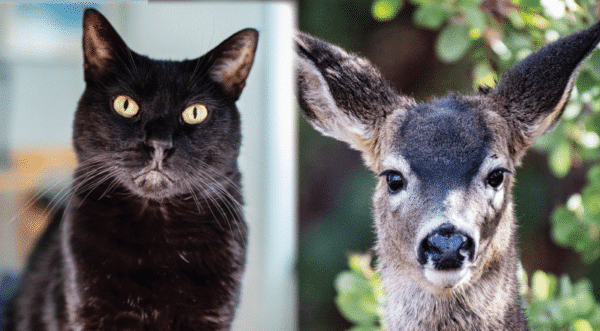
My family consists of two adults and two children. The fact that these children happen to be felines does not make them any less beloved. Nor does it mean we would ever think of referring to our Shelby or Gideon as “it.” This is true with most human families and their companion animals.
Unfortunately, the animals who live just outside of our homes receive far less linguistic respect. Rarely do you see a news article in which a raccoon or a chicken or deer is referred to as he or she.
For human animals, pronouns matter, more so than ever. People understandably want to have power over the words used to describe themselves. And if the nonhuman animals we share this planet with were able to tell us how to describe them, I bet they would ask us to stop using “it.”
“It” is an archaic holdover from a time in which animals were viewed as automata, thanks in part to the French philosopher René Descartes. In the 1600s, Descartes wrote that animals were little more than machines, unable to think or feel, giving doctors the false reassurance that they could operate on dogs and other animals without the use of anesthesia, a barbaric practice that ultimately gave rise to the modern animal protection movement.
We have come a very long way from those dark days, and it’s time our language caught up. Animals have moved from the wilderness into our homes. Millions of people are no longer eating animals or wearing their skins. And scientists continue to discover aspects of animals’ lives that bring them closer and closer to our own, such the knowledge that dolphins recognize themselves in mirrors, that crows fashion and use tools, and that rats enjoy a good tickle. It’s clear that the more we study animals, the smarter they become.
In 2012, a group of prominent scientists issued the Cambridge Declaration of Sentience, writing “…the weight of evidence indicates that humans are not unique in possessing the neurological substrates that generate consciousness. Non-human animals, including all mammals and birds, and many other creatures, including octopuses, also possess these neurological substrates.”
In other words, “it” hardly applies to animals any longer.
In 2021, a group of 80 animal advocates sent an open letter to the Associated Press urging them to update their stylebook to remove “it” from reference to animals:
The Associated Press Stylebook instructs writers not to apply a personal pronoun to an animal unless their sex has been established, or they have a name. This is too limiting to writers as well as fellow nonhuman animals, most of whom are discussed abstractly and thus their sex is not established. We pay respect to humans whose sex is indeterminate or gender fluid by using he/she or the non-binary term they. That same courtesy should be extended to all animals, as they are gendered beings.
I realize that dropping “it” requires answering an often-unanswerable question: “Is that animal a he or a she?” Even experts struggle to visually identify the genders of many species. Some animals provide hints via identifying features, such as antlers on deer (mostly) and the color schemes of birds (also mostly).
I offer a simpler solution: just pick one. He or she or they. Animals may be male or female or hermaphroditic. But no matter which pronoun you choose, you have close to even odds of guessing correctly.
However, if you use “it” you’ll always guess incorrectly because animals are not inanimate objects like clothing or coffee mugs. Animals are living, breathing, sentient creatures—a lot like us, the human species.
What about using the terms “ki” or “kin?” Robin Wall Kimmerer has suggested that we use these terms instead of it. While using ki and kin is a step forward, I don’t think the words go far enough. We don’t need another pronoun—we simply need to stop using the one word that separates us all.
There is, I believe, a deeper reason why we may resist using he or she to refer to animals, particularly when it comes to the animals we eat and hunt, such as deer and cows and chickens. It is far easier to kill and consume an animal that we believe can’t talk or dream or play—which all of these animals do. According to the USDA, more than 24 million chickens die every day in the US. To imagine every one of those chickens as a he or a she is to embark on a painful, personal journey: if we use he and she we might pause to eat fewer of our fellow he’s and she’s. That would be a life-altering change for many of us—but there’s no question it would be a good thing for the planet, and an even better thing for the animals.
The good news is that we are remarkably nimble at adapting our language to new circumstances. Many of us already give names to our automobiles or bikes. We also seem to have little trouble calling our devices by their given names, such as Siri and Alexa. So why not devote a little more effort to animals? The first step to repairing our relationship with animals begins with language.
The world faces many environmental challenges, as do the animals all around us. One way to move forward in a positive way would be to honor all animals—not only the ones who share our homes—with a he, she or they.
